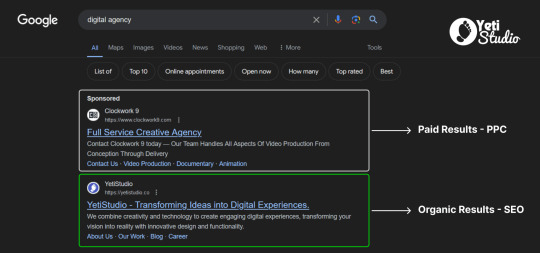Don't wanna be here? Send us removal request.
Text
The Ultimate Guide to SEO and SEM: Key Differences
The main difference between SEO and SEM is that SEO focuses on generating organic traffic by optimizing a website for organic search results whereas SEM focuses on driving traffic from organic and paid advertisements specifically PPC.

Figure: Types of Search Engine Marketing(SEM)
Let’s take an example.
When someone searches for anything in the Google search bar, he/she uses certain keywords to search for the things they are looking for. After searching, user find relevant results to their queries in the Google search results.
The Google search result is divided into two main categories: The paid search result section and the organic search result section.

Figure: Paid results and organic results in SERP
Figure: Organic vs Paid result demonstration in Search Engine Result Page (SERP)
The section below shows organic search results. It is usually done through 100% organic SEO optimization. No paid advertisement is used.
In this blog, you’ll learn about the major difference between SEO and SEM. Also, you will know about how it affects your website in Google SERP.
Now, let’s understand SEO and SEM in detail.
What is SEO?
SEO is the process of continually optimizing your website to rank at the top of SERP to increase organic traffic.
There are many tactics involved in SEO. But the major ones include:
On-Page SEO
Off-Page SEO
Technical SEO
1. On-Page SEO:

Figure: On-Page SEO techniques
2. Off-Page SEO:
Off-page SEO includes all the activities you perform outside of your website to increase its visibility and rankings on search engines. It is all about getting trust and authority signals from other websites.

Figure: Off-Page SEO Techniques
Let’s say, our website is getting backlinks from high DA websites on certain topics or content. This shows trust and authority to Google about our website and helps us to rank higher in the SERPs.
3. Technical SEO:

Figure: Technical SEO tactics
You need to make sure all your web content is crawlable so that search engines can index your pages in search results. It ensures that your site is optimized for search engines.
What is SEM?
SEM is the process of getting traffic to your website through organic SEO or Paid advertisement. Generally, Pay-per-click is used to get traffic from paid results.
It is the promotion of websites by increasing their visibility in search engine results pages (SERPs) through paid advertising. SEM includes both SEO and PPC (Pay-Per-Click) advertising strategies.
Pay-Per-Click:

Figure: Pay-Per-Click Advertisement
Key components of PPC:
1. Keyword Research :
The goal of keyword research for search engine marketing is to identify the most effective terms that consumers use to discover a good or service. This type of study aids in the efficient use of advertisements to run campaigns.
2. Ad creation and optimization :
Making ads that get clicked and result in conversions is your responsibility. The first step in all of this is crafting effective ad text. Next are strong calls to action and continuous tuning for better ad effectiveness.
3. Audience Targeting:
Targeting the right audience is crucial for maximizing the effectiveness of PPC campaigns. Identifying the target market, utilizing audience segmentation, and refining audience targeting based on data analysis are strategies to ensure that the ads reach out to the most relevant audience.
4. Optimizing Landing Page:
A well-designed landing page uses focused information, obvious calls-to-action, and fast load speeds to guarantee that any user who clicks on your ads has a relevant and seamless experience.
5. Bid Management:
You will get the maximum return on your money if you handle your advertising well. This entails making the appropriate bid revisions in light of competitor analysis and performance data.
6. Performance Tracking and Analytics:

Figure: SEO vs SEM
Conclusion:
SEO and SEM work together to form the two essential components of every digital marketing effort, each with its benefits and applications. SEM provides instant visibility and traffic through paid advertising, whereas SEO considers long-term, sustainable growth through organic search optimization. Knowing the differences between them can also assist businesses choose which one to pursue based on their timeframe, budget, or goal.
Choosing the right SEO and SEM strategy is crucial for any business. So, go for the strategies that best suit you and align with your business objectives.
0 notes